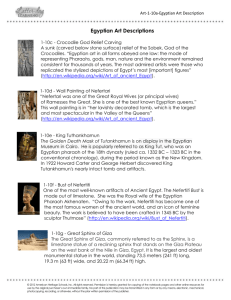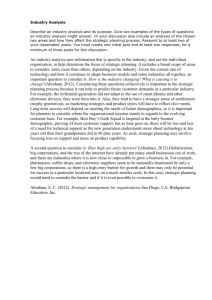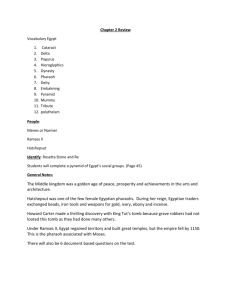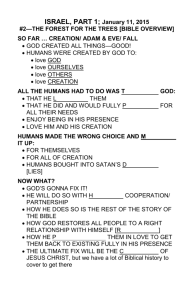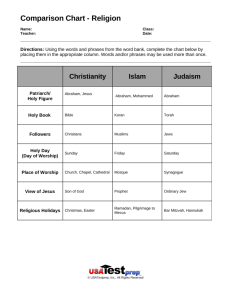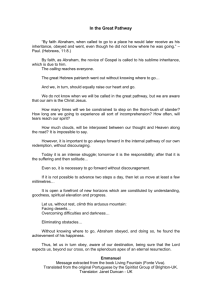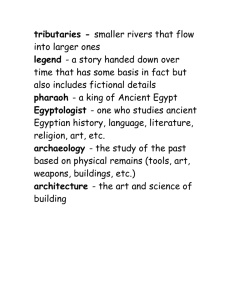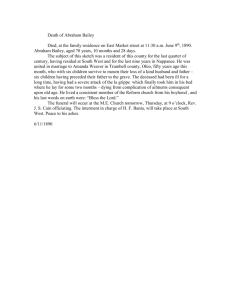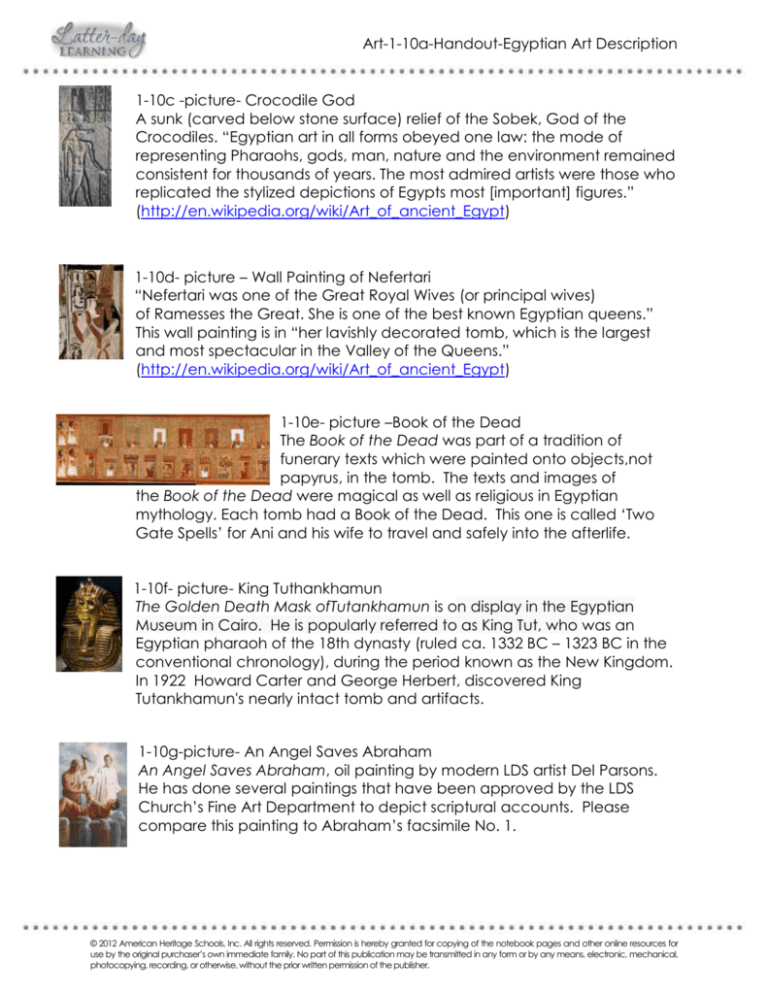
Art-1-10a-Handout-Egyptian Art Description
1-10c -picture- Crocodile God
A sunk (carved below stone surface) relief of the Sobek, God of the
Crocodiles. “Egyptian art in all forms obeyed one law: the mode of
representing Pharaohs, gods, man, nature and the environment remained
consistent for thousands of years. The most admired artists were those who
replicated the stylized depictions of Egypts most [important] figures.”
(http://en.wikipedia.org/wiki/Art_of_ancient_Egypt)
1-10d- picture – Wall Painting of Nefertari
“Nefertari was one of the Great Royal Wives (or principal wives)
of Ramesses the Great. She is one of the best known Egyptian queens.”
This wall painting is in “her lavishly decorated tomb, which is the largest
and most spectacular in the Valley of the Queens.”
(http://en.wikipedia.org/wiki/Art_of_ancient_Egypt)
1-10e- picture –Book of the Dead
The Book of the Dead was part of a tradition of
funerary texts which were painted onto objects,not
papyrus, in the tomb. The texts and images of
the Book of the Dead were magical as well as religious in Egyptian
mythology. Each tomb had a Book of the Dead. This one is called ‘Two
Gate Spells’ for Ani and his wife to travel and safely into the afterlife.
1-10f- picture- King Tuthankhamun
The Golden Death Mask ofTutankhamun is on display in the Egyptian
Museum in Cairo. He is popularly referred to as King Tut, who was an
Egyptian pharaoh of the 18th dynasty (ruled ca. 1332 BC – 1323 BC in the
conventional chronology), during the period known as the New Kingdom.
In 1922 Howard Carter and George Herbert, discovered King
Tutankhamun's nearly intact tomb and artifacts.
1-10g-picture- An Angel Saves Abraham
An Angel Saves Abraham, oil painting by modern LDS artist Del Parsons.
He has done several paintings that have been approved by the LDS
Church’s Fine Art Department to depict scriptural accounts. Please
compare this painting to Abraham’s facsimile No. 1.
© 2012 American Heritage Schools, Inc. All rights reserved. Permission is hereby granted for copying of the notebook pages and other online resources for
use by the original purchaser’s own immediate family. No part of this publication may be transmitted in any form or by any means, electronic, mechanical,
photocopying, recording, or otherwise, without the prior written permission of the publisher.
Art-1-10a-Handout-Egyptian Art Description
1-10h-picture-Bust of Nefertiti
One of the most well-known artifacts of Ancient Egypt. The Nefertiti Bust is
made out of limestone. She was the Royal wife of the Egyptian
Pharaoh Akhenaten. “Owing to the work, Nefertiti has become one of
the most famous women of the ancient world, and an icon of feminine
beauty. The work is believed to have been crafted in 1345 BC by the
sculptor Thutmose.” (http://en.wikipedia.org/wiki/Bust_of_Nefertiti)
1-10i-picture – Great Sphinx of Giza
The Great Sphinx of Giza, commonly referred to as the Sphinx, is a
limestone statue of a reclining sphinx that stands on the Giza Plateau
on the west bank of the Nile in Giza, Egypt. It is the largest and oldest
monumental statue in the world, standing 73.5 meters (241 ft) long,
19.3 m (63 ft) wide, and 20.22 m (66.34 ft) high.
1-10j-picture- Pryamids of Giza
The Pyramids of Giza are located outside of Cairo, Egypt next to
the Great Sphinx. They were constructed during the Old Kingdom
(2686-2181 BC). They are some of Ancient Egypt’s crowning
achievements and are one of the seven wonders of the world.
1-10k-picture- Abraham Facsimile 1
A Facsimile from the Book of Abraham, No. 1. This represents
an event in Abraham’s life. An Egyptian priest was about to kill
Abraham upon an alter, but the Lord (represented as a dove above
his head) came and delivered him out of the priest’s hands. (see
Abraham 1:7-20 for more explanation.) The Book of Abraham is
found in “The Pearl of Great Price” and it is a translation from Egyptian
papyri that came into the hands of Joseph Smith in 1835, containing
writings of the patriarch Abraham. (Pearl of Great Price, Book of
Abraham, pg.28)
1-10l-picture- Abraham Facsimile 3
A Facsimile from the Book of Abraham, No. 3. “Abraham is
reasoning upon the principles of Astronomy, in the king’s court. [He
is] sitting upon Pharaoh’s throne, by the politeness of the king, with
a crown upon his head, representing the Priesthood, as emblematical
of the grand Presidency in Heaven; with the scepter of justice and
judgment in his hand.” (Pearl of Great Price, Book of Abraham, pg.41)
© 2012 American Heritage Schools, Inc. All rights reserved. Permission is hereby granted for copying of the notebook pages and other online resources for
use by the original purchaser’s own immediate family. No part of this publication may be transmitted in any form or by any means, electronic, mechanical,
photocopying, recording, or otherwise, without the prior written permission of the publisher.

